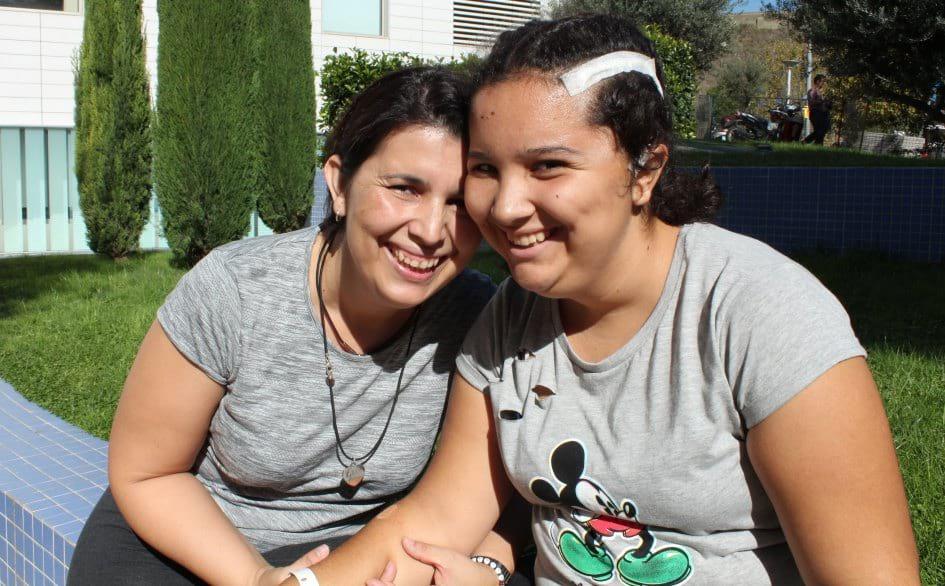
The surgery, performed by the neurosurgeons Jordi Rumià and Santiago Candela, put an end to the teenager’s refractory epilepsy.
It is easy to see Gara smiling: this teenage patient of SJD Barcelona Children’s Hospital’s Refractory Epilepsy Unit is known for her sense of humour. She is 16 years old, enjoys music and is passionate about rhythmic gymnastics. At just three years old Gara was diagnosed with epilepsy and as she got older, her disease became resistant to drugs. Her mother, Lourdes, briefly sums up how her disease progressed:
Gara has taken more than 40 different drugs over the years. None of them were effective in the long term.
The drugs Gara took became ineffective over time and the teenager got used to the epileptic seizures, which manifested as absence seizures of varying duration. She explains that she learned to identify when she was going to have a seizure. According to Lourdes, it was precisely this ability to live with her disease that meant that it took some time for the family to realise that the situation was gradually getting worse.
“They proposed the epilepsy surgery to us after an episode where Gara had more than 60 seizures in one day”, recounts Lourdes. “We were so used to the frequent seizures that until the day we had to monitor them, we weren’t fully aware of the situation. When the specialist from the Hospital de Las Palmas in Gran Canaria visited my daughter, she said we needed to look for solutions and immediately referred her to SJD Barcelona Children’s Hospital. By this point, Gara was suffering very frequent, almost daily, episodes that manifested primarily as absence seizures and loss of consciousness.
Neurosurgery is one option for patients with drug-resistant epilepsy like Gara.
Epileptologist Victoria San Antonio took on Gara’s case. She first performed an initial operation to implant intracranial electrodes, which she used to monitor brain activity and to define the area where the seizures were originating, to determine whether it would be possible to remove it. After this first surgery, numerous tests and a multidisciplinary analysis of the case, she concluded that Gara was a good candidate for neurosurgery.
The procedure consists of removing the focus of epilepsy, which in this case was located in the area that governs language. To ensure that her cognitive activity would not be affected, the operation had to be performed with the patient awake and her brain activity had to be monitored during the neurostimulation. This complex solution required Gara to be conscious and collaborate with the surgical team for a part of the procedure. In this case, the surgery was possible thanks to Gara’s age (she was 15 at the time), which meant that the teenager was able to collaborate with the surgical team at decisive moments during the operation. It is the first time SJD Barcelona Children’s Hospital has performed awake brain surgery on a pediatric patient in order to check in real time that brain activity is preserved while removing the affected parts.
The coordination of the surgical team was essential when performing the neurostimulation
The procedure was carried out in October 2017. The neurosurgeons Jordi Rumià and Santiago Candela performed the operation, in which 15 people participated simultaneously. First, Gara’s cranium was prepared for the intervention, and when the neurosurgeons judged the time was right, they signaled the anesthesiology team to wake her. One of the main challenges for the anesthesiology team, led by Silvia Serrano and Carolina Forero, was that after the first part of the surgery (under general anesthetic) the patient had to be woken up to collaborate with the team while under local anesthesia so she would not feel any pain.
Keeping Gara calm when she woke up and during the surgery was essential. Because of this, Ana López, the neuropsychologist, prepared her before the procedure and was present in the operating theatre to help her relax and carry out the actions the doctors asked her to perform: counting, reading or speaking at a certain speed. While she performed these actions, the neurophysiologist, Jana Climent, indicated the timing and intensity of the neurostimulation and monitored her brain activity. The use of electrodes in the operating theatre allowed the primary regions to be identified, but in order to ensure that complex and associative brain activity was not harmed, Gara had to read, count or talk to the professionals while they worked.
While the patient performed the requested activities, the neurophysiologist stimulated the areas to be removed to check whether there was any interference with language function and reading. If this happened, they avoided intervening in that area. If there was no difficulty, they removed that area of the brain.
The surgery was a success and Gara woke up with no damage to her cognitive activity. In fact, she did not even suffer any amnesia, which is common in patients of this type. Gara remembers the entire procedure and, more importantly for her, she has not had a single seizure since the day the operation was performed.



